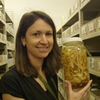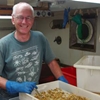General Description
Claws (chelipeds) unequal, larger and more elaborately toothed in males; fourth segment (merus) of larger claw (cheliped) with proximal hook on lower margin; sixth segment (propodus) smooth; fixed finger simple; last segment (dactylus) irregularly toothed in male. Tail fan (telson) tapering to convex posterior margin, as long as uropods. Cornea fully formed. Up to 3 cm long.
Biology
Ghost shrimps, sometimes called "Bass yabbies", "ghost nippers" or "one-armed bandits" in Victoria, dig deep permanent burrows on mud flats intertidally and on deeper sediment. In places like Western Port, the burrows can be found alongside seagrasses. Each burrow has two openings, one funnel-shaped down which water is drawn for ventilation, and another with a volcano built of mud excavated by the shrimp and dumped outside. This species is extremely common on muddy sediments in Port Phillip Bay.
Habitat
Subtidal muddy sediments to 100 m depth.
Soft substrates
Distribution guide
Southern temperate oceans, including south-eastern Australia.
Species Group
Prawns, shrimps, lobsters › Ghost and mud shrimps
Depth
Shallow (1-30 m)
Deep ( > 30 m)
Water Column
Max Size
3 cm
Diet
Organic matter
Harmful
Not harmful but a nip from large claws could be painful
Commercial Species
No
Global Dispersal
Native to Australia
Species Code
MoV 719
Conservation Status
- DSE Advisory List : Not listed
- EPBC Act 1999 : Not listed
- IUCN Red List : Not listed






